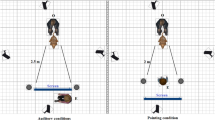Abstract
The present study assessed how dogs weigh gestural versus verbal information communicated to them by humans in transitive actions. The dogs were trained by their owners to fetch an object under three conditions: a bimodal congruent condition characterized by using gestures and voices simultaneously; a unimodal gestural condition characterized by using only gestures; and a unimodal verbal condition characterized by using only voices. An additional condition, defined as a bimodal incongruent condition, was later added, in which the gesture contrasted with the verbal command, that is, the owner indicated an object while pronouncing the name of the other object visible to dogs. In the incongruent condition, seven out of nine dogs choose to follow the gestural indication and performed above chance, two were at chance, whereas none of the dogs followed the verbal cues above chance. The dogs, as a group, performed above chance the gestural command in 73.6% of cases. The analysis of latencies in the above-mentioned four conditions exhibited significant differences. The unimodal verbal and the gestural conditions recorded a slower performance than both the bimodal incongruent and congruent conditions. No statistical differences were observed between the unimodal and bimodal conditions. Our results demonstrate that dogs, trained to respond equally well to gestural and verbal commands, choose to follow the indication provided by the gestural command than the verbal one to a significant extent in transitive actions. Furthermore, the responses to bimodal conditions were found to be quicker than the unimodal ones.




Similar content being viewed by others
References
Bell A, Meredith M, Van Opstal A, Munoz D (2005) Crossmodal integration in the primate superior colliculus underlying the preparation and initiation of saccadic eye movements. J Neurophysiol 93:3659–3673
Colonius H, Diederich A (2012) Intersensory facilitation. In: Seel ML (ed) Encyclopedia of the sciences of learning. Springer, New York, pp 1635–1638
Calvert GA, Spence C, Stein BE (2004) The handbook of multisensory processes. MIT Press, Cambridge, MA
D’Aniello B, Scandurra A (2016) Ontogenetic effects on gazing behaviour: a case study of kennel dogs (Labrador Retrievers) in the impossible task paradigm. Anim Cogn 19(3):565–570
D’Aniello B, Scandurra A, Prato-Previde E, Valsecchi P (2015) Gazing toward humans: a study on water rescue dogs using the impossible task paradigm. Behav Process 110:68–73
D’Aniello B, Scandurra A, Alterisio A, Valsecchi P, Prato-Previde E (2016) The importance of gestural communication: a study of human–dog communication using incongruent information. Anim Cogn 19:1231–1235
D’Aniello B, Alterisio A, Scandurra A, Petremolo E, Iommelli MR, Aria M (2017) What’s the point? Golden and Labrador retrievers living in kennels do not understand human pointing gestures. Anim Cogn 20:777–787
Déaux EC, Jennifer AC, Charrier I (2015) Aggressive bimodal communication in domestic dogs, Canis familiaris. PLoS ONE 10(11):e0142975
Fukuzawa M, Mills DS, Cooper JJ (2005) More than just a word: non-semantic command variables affect obedience in the domestic dos (Canis familiaris). Appl Anim Behav Sci 91:129–141
Gibson JM, Scavelli SA, Udell CH, Udell MAR (2014) Domestic dogs (Canis lupus familiaris) are sensitive to the “human” qualities of vocal commands. ABC 1(3):281–295
Glelen SCAM, Schmidt RA, van der Heuval PJM (1983) On the intersensory facilitation of reaction time. Percept Psychophys 34:161–168
Grassmann S, Tomasello M (2010) Young children follow pointing over words in interpreting acts of reference. Dev Sci 13:251–263
Grassmann S, Kaminski J, Tomasello M (2012) How two word-trained dogs integrate pointing and naming. Anim Cogn 15:657–665
Hare B, Tomasello M (1999) Domestic dogs (Canis familiaris) use human and conspecific social cue to locate hidden food. J Comp Psychol 113:173–177
Kaminski J (2008) Dogs (Canis familiaris) are adapted to receive human communication. In: Berthoz A, Christen Y (eds) Neurobiology of ‘‘Umwelt’’: how living beings perceive the world, research and perspectives in neurosciences. Springer, Heidelberg
Kaminski J, Nitzschner M (2013) Do dogs get the point? A review of dog-human communication ability. Learn Motiv 44:294–302
Kaminski J, Call J, Fischer J (2004) Word learning in a domestic dog: evidence for ‘‘fast mapping’’. Science 304:1682–1683
Lakatos G, Soproni K, Dóka A, Miklósi Á (2009) A comparative approach to dogs’ (Canis familiaris) and human infants’ comprehension of various forms of pointing gestures. Anim Cogn 2:621–631
Lakatos G, Gácsi M, Topál J, Miklósi Á (2012) Comprehension and utilization of pointing gestures and gazing in dog–human communication in relatively complex situations. Anim Cogn 15:201–213
Messing L (1990) Bimodal communication. The sixteenth LACUS forum 1989. LACUS, Lake Bluff
Miklósi Á (2007) Dog behaviour, evolution and cognition. Oxford University Press, Oxford
Miklósi Á (2009) Evolutionary approach to communication between humans and dogs. Vet Res Commun 33(Suppl 1):S53–S59
Miklósi Á, Soproni K (2006) A comparative analysis of animals’ understanding of the human pointing gesture. Anim Cogn 9:81–93
Miklósi Á, Kubinyi E, Topál J, Gácsi M, Virányi Z, Csányi V (2003) A simple reason for a big difference: wolves do not look back at humans, but dogs do. Curr Biol 13:763–766
Miller J (1982) Divided attention: evidence for coactivation with signals. Cogn Psychol 14:247–279
Mills DS (2005) What’s in a word? A review of the attributes of a command affecting the performance of pet dogs. Anthrozoös 18:208–221
Partan SR, Marler P (1999) Communication goes multimodal. Science 283(5406):1272–1273
Partan SR, Marler P (2005) Issues in the classification of multimodal communication signals. Am Nat 166(2):231–245
Pilley JW, Reid AK (2011) Border collie comprehends object names as verbal referents. Behav Process 86:184–195
Prato-Previde E, Marshall-Pescini S (2014) Social looking in the domestic dog. In: Horowitz A (ed) Domestic dog cognition and behavior. Springer, Berlin, pp 101–131
Rowland B, Quessy S, Stanford T, Stein B (2007) Multisensory integration shortens physiological response latencies. J Neurosci 22:5879–5884
Scandurra A, Prato-Previde E, Valsecchi P, Aria M, D’Aniello B (2015) Guide dogs as a model for investigating the effect of life experience and training on gazing behaviour. Anim Cogn 18(4):937–944
Scandurra A, Alterisio A, Marinelli L, Mongillo P, Semin GR, D’Aniello B (2017) Effectiveness of verbal and gestural signals and familiarity with signal-senders on the performance of working dogs. Appl Anim Behav Sci 191:78–83
Scheider L, Grassmann S, Kaminski J, Tomasello M (2011) Domestic dogs use contextual information and tone of voice when following a human pointing gesture. PLoS ONE 6(7):e21676
Soproni K, Miklósi Á, Topál J, Csányi V (2001) Comprehension of human communicative signs in pet dogs. J Comp Psychol 115:122–126
Soproni K, Miklósi Á, Topál J, Csányi V (2002) Dogs’ (Canis familiaris) responsiveness to human pointing gestures. J Comp Psychol 116:27–34
Stein BE, Stanford TR (2008) Multisensory integration: current issues from the perspective of the single neuron. Nat Rev Neurol 9:255–266
Topál J, Gergely G, Erdöhegyi A, Csibra G, Miklósi Á (2009) Differential sensitivity to human communication in dogs, wolves, and human infants. Science 325:1269–1271
Udell MAR, Dorey NR, Wynne CDL (2008a) Wolves outperform dogs in following human social cues. Anim Behav 76:1767–1773
Udell MAR, Giglio R, Wynne CDL (2008b) Domestic dogs (Canis familiaris) use human gestures but not non-human tokens to find hidden food. J Comp Psychol 122:84–93
Uetz GW, Roberts JA (2002) Multisensory cues and multimodal communication in spiders: insights from video/audio playback studies. Brain Behav Evol 59:222–230
Uetz GW, Roberts JA, Taylor PW (2009) Multimodal communication and mate choice in wolf spiders: female response to multimodal versus unimodal signals. Anim Behav 78(2):299–305
Wilcox RR, Keselman HJ (2003) Modern robust data analysis methods: measures of central tendency. Psychol Methods 8(3):254
Wobber V, Kaminski J (2011) What do dogs understand about human communicative signals? A novel synthesis. In: deGiovine V (ed) Dogs: biology, behavior, and health disorders. Nova Press, New York, pp 93–110
Acknowledgements
The authors would like to thank all trainer–students, who participated in tests with great enthusiasm. This research project was supported through ordinary funding from the University of Naples “Federico II.”
Author information
Authors and Affiliations
Corresponding author
Ethics declarations
Conflict of interest
The authors declare that they have no conflict of interest to declare.
Informed consent
Informed consent was obtained from the owners of all dogs included in the study.
Ethical approval
This study was approved by the Ethical Animal Care and Use Committee of the University of Naples “Federico II” (protocol number 2017/0025509). All applicable international, national, and/or institutional guidelines for the care and use of animals were followed.
Rights and permissions
About this article
Cite this article
Scandurra, A., Alterisio, A., Aria, M. et al. Should I fetch one or the other? A study on dogs on the object choice in the bimodal contrasting paradigm. Anim Cogn 21, 119–126 (2018). https://doi.org/10.1007/s10071-017-1145-z
Received:
Revised:
Accepted:
Published:
Issue Date:
DOI: https://doi.org/10.1007/s10071-017-1145-z




